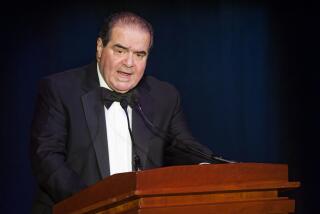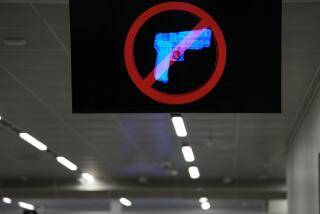Ruling Limits Use of Stun Belts in Court
The use of electric stun belts to control verbal courtroom outbursts by defendants is unconstitutional, but the devices can be used if there is a security threat, a federal appeals court in San Francisco ruled Wednesday.
In a 3-0 decision, the U.S. 9th Circuit Court of Appeals ruled that a Long Beach judge violated Ronnie Hawkinsâ rights when she ordered a bailiff to administer a 50,000-volt jolt of electricity to Hawkins after he interrupted her comments during a hearing.
It was the first time a stun belt had been used in a Los Angeles County courtroom and the case had been closely watched, with human rights groups such as Amnesty International decrying use of the devices as high-tech torture.
Hawkins sued Judge Joan Comparet-Cassani, the Los Angeles Municipal Court and the county Sheriffâs Department. In November 1998, Los Angeles District Judge Dean D. Pregerson issued a preliminary injunction prohibiting the use of the stun belt, saying it violated several constitutional rights.
Pregerson said the mere threat of use of the stun belt has a âchilling effectâ on a defendantâs right to represent himself because it would put him in fear of the consequences of advocating his own cause.
During a 1998 sentencing hearing, Hawkins, who had been fitted with the stun belt because of earlier violence in jail, angered Comparet-Cassani by interrupting her repeatedly and by violating her order not to tell jurors that he was HIV-positive and was facing a sentence of 25 years to life on a theft charge.
He was facing the lengthy term under the stateâs three-strikes law because of six prior convictions for robbery and attempted robbery.
At one point, Hawkins asked the judge, âYou are going to electrocute me for talking?â
The judge responded, âNo sir. but they will zap you if you keep doing it,â meaning interrupting her.
In his 1998 ruling, Pregerson said that the boundary âbetween aggressive advocacy and a breach of orderâ is âinherently hard to defineâ and that defendants might refrain from the former fearing a 50,000-volt jolt.
The appeals court agreed Wednesday, saying that âthe psychological toll exacted by such constant fear is one of the selling points made by the manufacturer of the belt.â
The opinion by Judge James R. Browning cited the manufacturerâs promotional literature, which trumpeted the âtotal psychological supremacy [over] troublesome prisoners.â
The court also quoted, approvingly, Pregersonâs conclusion that if the stun belt is activated a case would be compromised even more because it would render the defendant unable âto meaningfully participate in the proceeding.â
âThe district courtâs findings are credible, largely uncontested, and consistent with other reported opinions,â Browning wrote. Judge A. Wallace Tashima and U.S. District Judge Samuel P. King joined in the decision.
âThe âchilling effectâ the court describes obviously prejudices a defendantâs 6th Amendment guarantee of a fair trial. We therefore sympathize with the district courtâs conclusion that a device with such dangerous potential âdoes not belong in a court of law.â â
However, the appellate judges said in Hawkins vs. Comparet-Cassani et al that Pregersonâs findings do not support his conclusion that serious questions exist on whether the use of the stun belt violates the 6th Amendment in all cases.
âThere is an important difference between verbal disruption and conduct that threatens courtroom security,â Browning wrote, acknowledging a point from a friend-of-the court brief filed by the U.S. Justice Department.
The 9th Circuit acknowledged Pregersonâs conclusion that there was a fine line between aggressive advocacy and expression that disrupts courtroom order. But the judges noted that âthreats of violence or escape are sufficiently identifiable to permit a defendant to advocate his cause without fear that excessive zealousness will be mistaken for such a threat.â
The judges added that Pregersonâs concerns about a âchilling effectâ would be less compelling if use of the belt were restricted to preventing violence or escape.
The 9th Circuit sent the case back to Pregerson with instructions to modify his injunction.
Venice attorney Stephen Yagman, who filed the case for Hawkins, hailed the 9th Circuit for upholding âa prohibition on torture.â Yagman said he agreed with the distinction the court articulated.
âI agree with the court that it would be appropriate to use the stun belt for security but not for disruptions,â Yagman said.
Kevin C. Brazile, principal deputy county counsel, who represented the Sheriffâs Department, said he was pleased the court reversed part of Pregersonâs decision.
He said he did not think the county would appeal because the county âcan live withâ the decision. âWe can craft policies to use the stun belt, using the [9th Circuit] opinion as a guideline,â Brazile added.
After the 1998 incident, Hawkins got a new trial, but he was convicted again for stealing $250 in painkillers from a Long Beach market.
More to Read
Sign up for Essential California
The most important California stories and recommendations in your inbox every morning.
You may occasionally receive promotional content from the Los Angeles Times.










